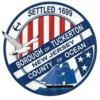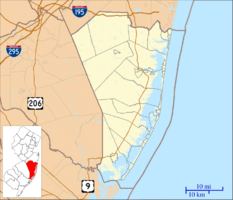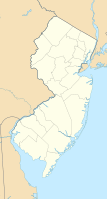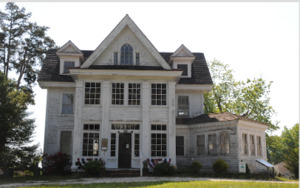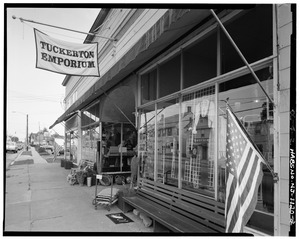Tuckerton, New Jersey facts for kids
Quick facts for kids
Tuckerton, New Jersey
|
||
|---|---|---|
|
Borough
|
||
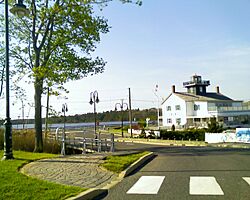
The Tuckerton Seaport maritime museum
|
||
|
||
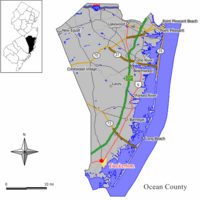
Map of Tuckerton in Ocean County. Inset: Location of Ocean County highlighted in the State of New Jersey.
|
||
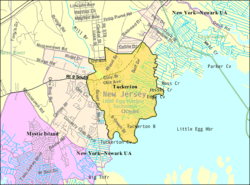
Census Bureau map of Tuckerton, New Jersey
|
||
| Country | ||
| State | ||
| County | ||
| Incorporated | February 18, 1901 | |
| Named for | Ebenezer Tucker | |
| Government | ||
| • Type | Borough | |
| • Body | Borough Council | |
| Area | ||
| • Total | 3.81 sq mi (9.87 km2) | |
| • Land | 3.36 sq mi (8.71 km2) | |
| • Water | 0.45 sq mi (1.16 km2) 11.76% | |
| Area rank | 304th of 565 in state 16th of 33 in county |
|
| Elevation | 0 ft (0 m) | |
| Population
(2020)
|
||
| • Total | 3,577 | |
| • Estimate
(2023)
|
3,681 | |
| • Rank | 427th of 565 in state 17th of 33 in county |
|
| • Density | 1,063.8/sq mi (410.7/km2) | |
| • Density rank | 375th of 565 in state 18th of 33 in county |
|
| Time zone | UTC−05:00 (Eastern (EST)) | |
| • Summer (DST) | UTC−04:00 (Eastern (EDT)) | |
| ZIP Code |
08087
|
|
| Area code(s) | 609 Exchanges: 294, 296, 812 | |
| FIPS code | 3402974210 | |
| GNIS feature ID | 885422 | |
| Website | ||
Tuckerton is a small town, called a borough, located on the Jersey Shore in Ocean County, New Jersey. In 2020, 3,577 people lived here. This was the highest number of people ever recorded in Tuckerton during a census.
The town officially became a borough on February 18, 1901. It was formed from parts of Little Egg Harbor Township. Even though Tuckerton is surrounded by Little Egg Harbor Township, it is its own separate town. Many people often refer to the surrounding areas as "Tuckerton" because they share the same ZIP code (08087).
Tuckerton is famous for the Tuckerton Seaport, which is a fun maritime museum and village.
Contents
History of Tuckerton
The area where Tuckerton is today was first settled way back in 1698. Some of the first families to live here were the Andrews, Falkinburgs, Shourds, Ongs, Willets, and Osborns. Edward Andrews built a special cedar log grist mill in 1704. This mill helped grind grain and still stands today!
Tuckerton became an official "Port of Entry" for the United States. This meant ships could bring goods into the country through this port. The town is named after its founder, Ebenezer Tucker (1758–1845). He was appointed as the Collector for the port in 1791 by George Washington himself!
How Tuckerton Got Its Name
Before it was called Tuckerton, the town had many different names like "Andrew Mills," "Clamtown," and "Fishtown." In 1789, Ebenezer Tucker hosted a big party in Clamtown. At this party, the residents decided to officially change the name to Tuckerton.
Early Travel and Transportation
In 1816, Isaac Jenkins started the first stagecoach line between Tuckerton and Philadelphia. This trip took two days each way! Later, John D. Thompson bought the line and made the trip faster, carrying mail too. Stagecoaches and boats were the main ways to travel until the Tuckerton Railroad was built in 1871.
Tucker's Island: A Lost Resort
New Jersey's first summer resort was probably on Tucker's Island, located offshore from Little Egg Harbor. This island had places to stay, private homes, and even a school. A lighthouse was built there in 1848. Sadly, a big storm completely wiped away the island and its lighthouse.
Today, at the Tuckerton Seaport Museum, you can see a re-created lighthouse and other buildings that were on Tucker's Island. Inside the lighthouse, there are pictures showing the moment the original lighthouse fell into the sea. The real island is still underwater.
Tuckerton's Downtown Area
By the early 1800s, Tuckerton had a busy downtown with many shops, boarding houses, and hotels. Ebenezer Tucker built the "Union House" around 1800. It was a post office, a stop for stagecoaches, and a place for people to stay. This building later became the "Carlton House" and was an inn until it burned down in 1964.
The Tuckerton Methodist Episcopal Church was first started in 1797. In 1868, a beautiful new church building was constructed. It had a tall steeple, stained glass windows, a town clock, and a pipe organ. Shipbuilders helped construct this church, showing how important shipping and fishing were to the town.
In 1921, Reuben Gerber opened Gerber's Department Store on Main Street. The store's art deco design was inspired by the famous Macy's Herald Square store in New York City. Gerber's was the main general store and even sold early Ford cars. Today, the building is called the "Tuckerton Emporium" and has many local shops inside.
Major Events and Disasters
On May 7, 1979, a large fire destroyed the old Tuckerton United Methodist Church, two stores, and several homes on Main Street. Strong winds helped the fire spread quickly. Many fire departments from nearby areas came to help put out the blaze.
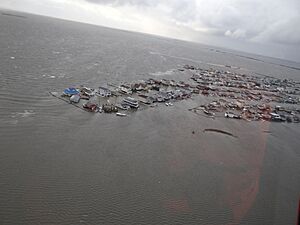
Tuckerton was also badly damaged by Superstorm Sandy on October 28, 2012. Almost 300 homes were heavily damaged, and 32 homes were completely destroyed. Floodwaters also affected businesses and some buildings at the Tuckerton Seaport.
Geography and Climate
Tuckerton covers about 3.81 square miles (9.87 square kilometers). Most of this area is land, but about 0.45 square miles (1.16 square kilometers) is water.
The borough shares its borders only with Little Egg Harbor Township in Ocean County.
Tuckerton's Climate
The weather in Tuckerton has hot, humid summers and usually mild to cool winters. This type of weather is known as a humid subtropical climate.
Population and People
| Historical population | |||
|---|---|---|---|
| Census | Pop. | %± | |
| 1910 | 1,268 | — | |
| 1920 | 1,106 | −12.8% | |
| 1930 | 1,429 | 29.2% | |
| 1940 | 1,320 | −7.6% | |
| 1950 | 1,332 | 0.9% | |
| 1960 | 1,536 | 15.3% | |
| 1970 | 1,926 | 25.4% | |
| 1980 | 2,472 | 28.3% | |
| 1990 | 3,048 | 23.3% | |
| 2000 | 3,517 | 15.4% | |
| 2010 | 3,347 | −4.8% | |
| 2020 | 3,577 | 6.9% | |
| 2023 (est.) | 3,681 | 10.0% | |
| Population sources: 1910–2000 1910–1920 1910 1910–1930 1940–2000 2000 2010 2020 |
|||
2010 Census Information
In 2010, there were 3,347 people living in Tuckerton. Most residents, about 93.79%, were White. About 6.07% of the population identified as Hispanic or Latino.
The average age of people in Tuckerton was 42.5 years old. About 21.2% of the population was under 18 years old. The average household had 2.39 people living in it.
Arts and Culture

The Tuckerton Seaport is a major attraction in the town. It's a museum and village that shows what life was like in a maritime community. It opened in May 2000 and has many re-created historic buildings.
Main Street in Tuckerton has several shops and stores. Near Lake Pohatcong, there's a unique billboard shaped like a duck decoy. This billboard advertises the annual Ocean County Decoy and Gunning Show. This popular event started in 1982 and attracts thousands of visitors every September. During the holidays, the duck is replaced with a Christmas tree.
Education in Tuckerton
Elementary School
Students in pre-kindergarten through sixth grade attend Tuckerton Elementary School. This school is part of the Tuckerton School District. In the 2020–21 school year, the school had 311 students and 32 teachers. This means there were about 9.7 students for every teacher.
Middle and High School
Students in seventh through twelfth grades go to schools in the Pinelands Regional School District. This district also serves students from nearby towns like Bass River Township, Eagleswood Township, and Little Egg Harbor Township.
The schools in this district are:
- Pinelands Regional Junior High School: For students in grades 7-8.
- Pinelands Regional High School: For students in grades 9-12.
The school board has nine members who are elected by the residents of these towns. Tuckerton has one seat on this board.
Media and Communications
Tuckerton is home to the tallest structure in New Jersey. This tower is 1,000 feet tall and broadcasts the Philadelphia Telemundo TV station, WWSI.
The radio station 99.7 WBHX-FM is licensed to Tuckerton. Its signal can be heard in areas like Toms River and Atlantic City. This station plays the same music as "Fun 107" from 107.1 WWZY.
Tuckerton is also a place where underwater communication cables come ashore. One of these is the GlobeNet cable, which helps connect different parts of the world with internet and phone services.
Transportation
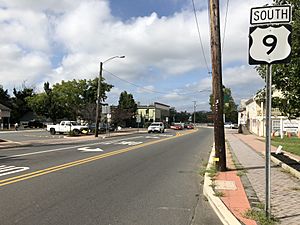
Roads and Highways
As of 2010, Tuckerton had almost 20 miles of roads. The town maintains most of these roads.
U.S. Route 9 runs through the northern part of Tuckerton. This route connects with CR 539.
The Garden State Parkway is a major highway nearby. You can get to it from Route 539 (Exit 58) or US 9 (Exit 50).
Public Transportation
NJ Transit provides bus service from Tuckerton to Atlantic City on the 559 bus route.
There is also a local bus service called Ocean Ride. The OC6 route connects Little Egg Harbor and Stafford.
Notable People from Tuckerton
Many interesting people have connections to Tuckerton:
- Ezra Baker (born around 1765), who served as a U.S. Representative for New Jersey.
- Mathilde Cottrelly (1851–1933), a German-born actress, singer, and theater manager.
- Gina Krasley (1991–2021), who was featured on the TV show My 600-lb Life.
- W. Steelman Mathis (1898–1981), a politician who served in the New Jersey Senate.
- Ebenezer Tucker (1758–1845), the founder of the borough, after whom the town is named. He was also a member of the United States House of Representatives.
See also
 In Spanish: Tuckerton para niños
In Spanish: Tuckerton para niños


